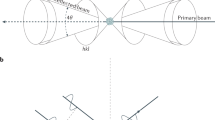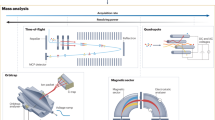Abstract
IN some experiments reported in 19571 on the transfer of material by electrons of a few hundred volts energy, bombarding targets of barium, strontium, sodium and cæsium, it was noticed that the enlarged electron microscope image of the emitter showed unresolved changes in contrast (as well as in emission) only when material had been deposited on it. It was established that a portion of this was brought to the emitter in the form of positive ions, which, guided by the electron-optical field between emitter and target, came back to form random regions about 100µ, in diameter.
This is a preview of subscription content, access via your institution
Access options
Subscribe to this journal
Receive 51 print issues and online access
$199.00 per year
only $3.90 per issue
Buy this article
- Purchase on Springer Link
- Instant access to full article PDF
Prices may be subject to local taxes which are calculated during checkout
Similar content being viewed by others
References
J. Electronics and Control, 3, 339 (1957).
J. App. Phys., 24, 860 (1953).
Author information
Authors and Affiliations
Rights and permissions
About this article
Cite this article
JACOB, L. Detection of Single Slow Ions : a Method of Pressure Measurement. Nature 198, 774–775 (1963). https://doi.org/10.1038/198774b0
Issue Date:
DOI: https://doi.org/10.1038/198774b0
This article is cited by
Comments
By submitting a comment you agree to abide by our Terms and Community Guidelines. If you find something abusive or that does not comply with our terms or guidelines please flag it as inappropriate.



